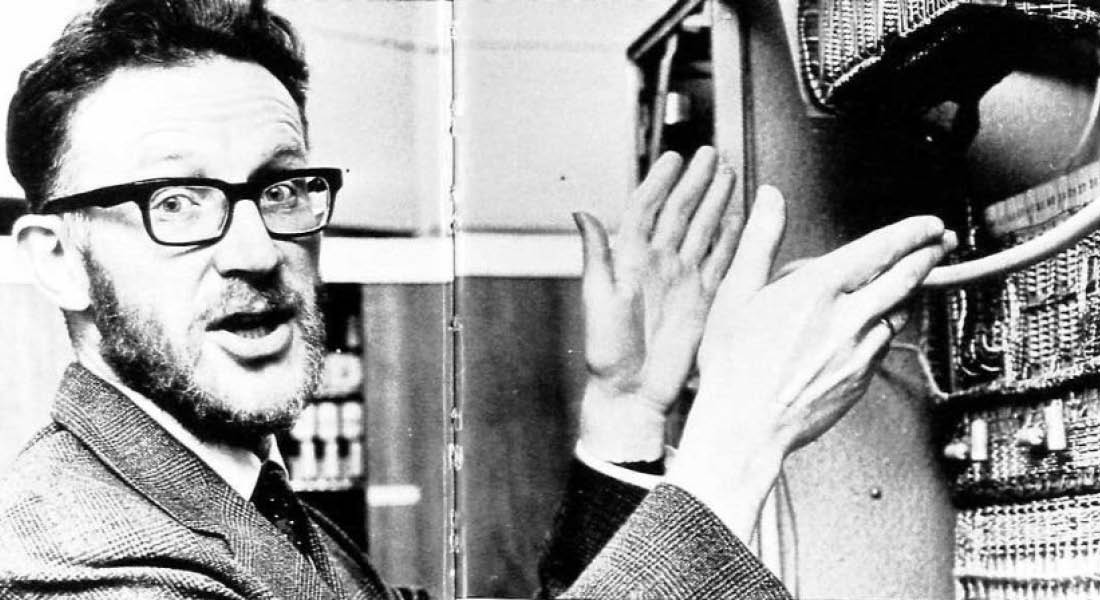Before the department

The early years of Danish computer science
The early development of computer science as a discipline in Denmark and internationally began in the mid-1950s. In 1955, Regnecentralen, the Danish Institute of Computing Machinery – popularly known as Denmark’s first IT company, was set up. To begin with, however, Regnecentralen was a non-profit department under the Danish Academy of Technical Sciences.
A group of mathematicians, physicists and astronomers, headed by Niels Ivar Bech, developed electronic calculators at Regnecentralen. The group built Denmark’s first computer named DASK (Danish Arithmetical Sequence Calculator), which was completed in 1958 and took up two whole living rooms of space in the house in which Regnecentralen was based.
Peter Naur, who later became the founder of DIKU, was among the pioneers at Regnecentralen. He was also the main author of the famous ALGOL 60 report, which is regarded as one of the most influential programming languages ever created.
A groundbreaking programming language
As the name suggests, ALGOL 60 saw the light of day in 1960 when the committee published a report on the structure of the programming language. ALGOL 60 set the agenda for future computer science research, and some of the ideas from ALGOL 60 are today so widespread that it is almost implausible for software developers not to use them in their programming.
With the ALGOL 60 report, the development of formal definitions of a whole programming language was commenced for the first time, so that as many as possible could understand and implement ALGOL. The report introduced the Backus-Naur Form, famous among programmers, which is used to describe the structure of virtually all programming languages.
This is particularly the aspect for which Peter Naur became world-famous: He made programs designed to be user-friendly. This means programs not designed solely on the basis of machines, but composed in a way that makes it easier for people to grasp them.
In 2005, Peter Naur received the Turing Award, including for his work with defining the ALGOL 60 language. To date, he is the only Dane to receive this award, which is regarded as the Nobel Prize of Computing.

The University of Copenhagen buys its first computer
In the early 1960s, a number of mathematicians and physicists at the University of Copenhagen realised that the opportunities offered by computers would become of central importance in a number of areas of society in the future. There was a need for education and research in this field. Therefore, in 1963, the Department of Mathematics purchased an electronic GIER computer for use on a course on numerical calculations.
GIER was Denmark’s second computer, and, like DASK, it was developed at Regnecentralen by Peter Naur, among others. More specifically, Peter Naur developed the ALGOL compiler for GIER. GIER was to replace the work with solving equations, which, until then, the mathematicians had done using manual calculators and tables. Unlike manual calculators, GIER was programmed to perform advanced calculations.
Therefore, part of the teaching also focused on introducing the students to programming with the ALGOL 60 language. With the procurement of GIER and with programming as part of the syllabus, the University of Copenhagen thus took the first step towards establishing computer science as an independent discipline.

Naur invents ‘Datalogy’ and predicts the importance of computers to society
In the mid-1960s, the technological development begins to take off. Computers become faster and far more efficient at solving different tasks. They also become smaller in size and less expensive to produce, making it possible for more companies and institutions to buy them.
In 1966, Peter Naur invents the term ‘datalogy’, which he explained as “the science of the nature and use of data”. He thought this was a more adequate term for the discipline than ‘computer science’. This view of the discipline, with the focus being more on data than on computers, has since become known as The Copenhagen Tradition.
In the same year, Peter Naur received the Rosenkjær Award of the Danish Broadcasting Corporation (DR) for his public radio lectures on the importance of computers to society. In these lectures, he presented a series of almost alarmingly accurate predictions about what was in store for society.
Peter Naur's future perspectives
- Everyone would use a computer every day and have a personal computer
- Computers would be connected to central systems (servers and the Internet) and be a “significant extension of the telephone service” with “keys like a typewriter” and a TV screen
- Digital payment would be introduced, including online purchases and sales
- Digital search agents (like Jobindex) and digital lexicons (like Wikipedia) would be developed
- Digital monitoring of citizens would be possible, and this would entail a great risk of unauthorised use of personal data for other purposes than those to which the citizens had granted permission
- Computer science classes would be put on the timetable, right from the first grades.
